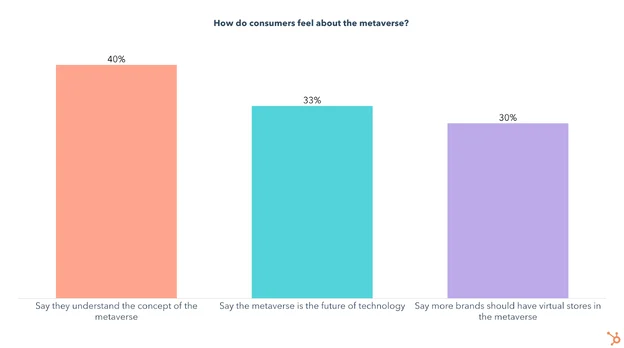How To Navigate Your Brand's Identity in the Metaverse: Branding the Virtual Frontier

Article summary
Discover innovative strategies and practical tips for brands to harness the power of the metaverse, from immersive experiences to virtual engagement. Dive into this comprehensive guide on leveraging this evolving landscape for unparalleled growth and consumer connection.
The metaverse is no longer a concept confined to the realms of science fiction. It's a burgeoning digital landscape where the boundaries between the physical and virtual worlds blur. As it gains traction, brands face the challenge and opportunity of establishing their identity in a space unlike any other.
What is the metaverse?
The metaverse is a collective virtual space created by combining physical reality and digital environments. It allows users to interact with each other and the computer-generated environment in real-time. Brands are increasingly recognizing the potential of this space for unique user engagement and interactive campaigns.
Why Brands Should Care
According to a Statista report, attitudes toward the metaverse and brands are a growing area of study. Among those who are taking interest are already exploring metaverse as a potent marketing tool.
Leading brands are now rewriting marketing rules to accommodate the metaverse. The term "metaverse" has seen a significant resurgence in public interest. Internet searches for the said term increased by 7,200 percent in 2021 alone. In 2021, metaverse-related companies reportedly raised upward of $10 billion, which is more than double the amount raised in the previous year.
Companies like Nike, for example, have applied for patents for their logos and slogans in preparation for a metaverse launch. Epic Games has successfully raised $2 billion to fund its long-term vision for the metaverse. They also announced a partnership with LEGO to build a metaverse for kids.
Facebook's rebranding to Meta and Microsoft's proposed acquisition of Activision are testaments to the growing corporate interest in this space.
The Evolution of Branding to Meta-Branding
The way companies do branding changes over time, depending on consumer preference. With the metaverse, branding is now more than logos, taglines, and traditional advertising. Brands are now embracing the concept of meta-branding. This concept goes beyond the surface-level elements of branding to create immersive, interactive experiences that redefine consumer engagement.
The usual way of branding often covers creating a unique image and voice for a company. It is common to see marketing encapsulated in visual elements and communicated through public relations.
Meta-branding, however, is about creating a brand's "meta" or "beyond" existence. It involves crafting a brand's presence using interactive experiences and virtual goods and services that can be traded or sold.
There's a huge reason why most brands are making the switch.
HubSpot surveyed over 1,000 U.S. consumers to understand their engagement with the metaverse. The survey revealed that eight percent of participants had visited a metaverse. While this may seem like a small percentage, half of these early adopters had done so in the past three months. Moreover, 30 percent of respondents believed more brands should leverage it.

Strategies for Successful Meta-Branding
With new trends come the need for effective strategies to navigate this new frontier. Below are key areas that brands should focus on to successfully implement meta-branding.
Increase user engagement through avatars
Creating brand-specific avatars is an innovative approach to consumer engagement. These avatars serve as virtual brand ambassadors that will represent the brand's values and interact with users in the metaverse. They can guide users through virtual stores, provide information, and even assist in virtual events. In a way, it makes the brand experience more personalized and interactive.
Leverage virtual real estate
Investing in virtual real estate offers brands an unparalleled opportunity to redefine consumer interaction. Virtual spaces created with the help of typical virtual tour software can range from showrooms displaying the brand's latest products to interactive experiences immersing users in the brand's world.
These spaces become destinations where consumers can engage with the brand in a way that goes beyond traditional physical or online stores. Additionally, leveraging a best real estate CRM system can enhance the management and organization of these virtual properties, ensuring efficient operations and maximizing engagement.
Invest in interactive campaigns
The metaverse serves as a platform for brands to launch interactive and highly personalized campaigns. Unlike traditional advertising, brands can adjust their campaigns to suit consumer preferences and behaviors.
By signing up I agree to the Terms of Use and Privacy Policy
The metaverse allows brands to create memorable experiences that resonate with consumers. In turn, this leads to a level of engagement that was previously unattainable.
Start small
The metaverse is vast, and the temptation to make a grand entrance can be overwhelming. However, a more prudent approach is to start small.
Begin with a single virtual office space or a focused campaign that aligns with your brand's core values and objectives. This lets you test the waters, gather valuable user feedback, and make necessary adjustments before scaling up.
An incremental approach reduces risk and provides a more manageable pathway to establish your brand in the metaverse.
Focus on user experience
User experience (UX) is always a top priority for brands. The same still applies in the metaverse. A well-designed, user-friendly virtual environment can significantly enhance user engagement and brand loyalty. During the design process, every touchpoint should consider the user's comfort and convenience. Think about the ease of navigation in your virtual store or the intuitiveness of your interactive campaign.
Tighten data security
The digital nature of the metaverse brings with it a host of data security concerns. As users interact with your brand in a virtual space, they often share personal information, from contact details to behavioral data. Ensuring solid data security measures are in place is not just a technical requirement. It's imperative for brands to have teams with recognized cyber security certifications, ensuring they are well-equipped to implement and manage these measures effectively. When navigating the metaverse, brands must carefully consider their data security protocols and DSPM strategy, especially in the face of the growing digital landscape. The choice between NordVPN, ExpressVPN, Surfshark and Perimeter 81 becomes pivotal, as these VPN services offer varying features and levels of encryption to safeguard users' personal information in virtual spaces. Brands should meticulously assess the capabilities of these VPNs and equip their cybersecurity teams with recognized certifications to adeptly implement and manage robust data security measures, aligning with the NIS2 directive requirements.
Brands should consider it their responsibility to their consumers. VR headsets, for one, can capture personal data. Consumers should know how brands collect, use, and delete their personally identifiable information (PII).
Brands must adhere to stringent data protection regulations and employ state-of-the-art encryption methods to safeguard user data. They should also use an advanced threat detection tool to identify and mitigate potential security risks, ensuring strong protection for their users..
Safeguard brand identity
In the ever-expanding realm of the metaverse, safeguarding your brand's identity goes beyond just logos and taglines. One often overlooked but crucial aspect is the trademarking of usernames.
Brands have been quick to secure domain names in the early days of the internet. They should apply the same level of urgency to usernames in the metaverse. This ensures that your brand's identity remains consistent and protected across various virtual platforms.
Trademarking your username prevents brand impersonation and reinforces your brand's presence in the virtual world.
Take the Leap Into the Metaverse
The digital space will continue to change. Brands that successfully navigate the dynamic landscape will be the ones that consumers will rely on, both in the virtual world and the real one. So take that leap. Now is the time to strategize your brand's meta-existence and lead the way in this new paradigm.













